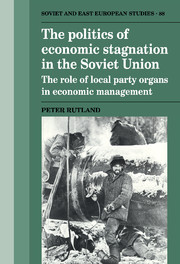 The Politics of Economic Stagnation in the Soviet Union
The Politics of Economic Stagnation in the Soviet Union Book contents
- Frontmatter
- Contents
- List of tables
- Preface
- Glossary of Russian terms and abbreviation
- Introduction: The party in the post-totalitarian system
- 1 The party and the economy: structures and principles
- 2 Party interventions in industry
- 3 Interventions in industry: case studies
- 4 The party as regional coordinator
- 5 Regional coordination: case studies
- 6 The party as fireman: party interventions in the transport and energy sectors
- 7 The role of the party in agriculture
- 8 Non-party control organs
- 9 The principles underlying the party's work with cadres
- 10 The obkom elite in the 1980s
- 11 Party and economy under perestroika
- Conclusion Party and economy in the USSR: from stagnation to collapse
- Appendices
- Notes
- Bibliography
- Index
- THE POLITICS OF ECONOMIC STAGNATION IN THE SOVIET UNION
10 - The obkom elite in the 1980s
Published online by Cambridge University Press: 06 July 2010
- Frontmatter
- Contents
- List of tables
- Preface
- Glossary of Russian terms and abbreviation
- Introduction: The party in the post-totalitarian system
- 1 The party and the economy: structures and principles
- 2 Party interventions in industry
- 3 Interventions in industry: case studies
- 4 The party as regional coordinator
- 5 Regional coordination: case studies
- 6 The party as fireman: party interventions in the transport and energy sectors
- 7 The role of the party in agriculture
- 8 Non-party control organs
- 9 The principles underlying the party's work with cadres
- 10 The obkom elite in the 1980s
- 11 Party and economy under perestroika
- Conclusion Party and economy in the USSR: from stagnation to collapse
- Appendices
- Notes
- Bibliography
- Index
- THE POLITICS OF ECONOMIC STAGNATION IN THE SOVIET UNION
Summary
This chapter presents the results of a study of the career backgrounds of obkom first secretaries in the 1976–88 period. The primary goal was to look for evidence of the conflict between political and economic ways of thinking. J. Hough pioneered the use of career biographies as a source for the study of political change in regional party elites. Did the trends which Hough identified carry through to the mid-1980s? Did the qualifications of new entrants to the apparatus in the late Brezhnev era differ from those of their predecessors?
The opening section examines the pattern of career paths into the obkom first secretary position and the degree of geographical mobility they displayed. The second section looks at the evidence for generational turnover in the 1980s (an issue central to Hough's argument). The final section examines whether the technical qualifications of regional party leaders improved over time, as Hough suggested – the implication being that this made them better able to play the role as coordinator of their region's economy.
Before presenting the results, three caveats are in order with respect to the biographical approach. First, the argument in this book is based on an analysis of how structures worked, rather than a study of the characteristics of agents within those structures. This emphasis is partly because of the dearth of information about individual behaviour within the policy process. However, it is also because of a conviction that within the deeply entrenched bureaucratic culture of the USSR political institutions shaped and determined the behaviour of the individuals who staffed them.
- Type
- Chapter
- Information
- The Politics of Economic Stagnation in the Soviet UnionThe Role of Local Party Organs in Economic Management, pp. 188 - 205Publisher: Cambridge University PressPrint publication year: 1992
